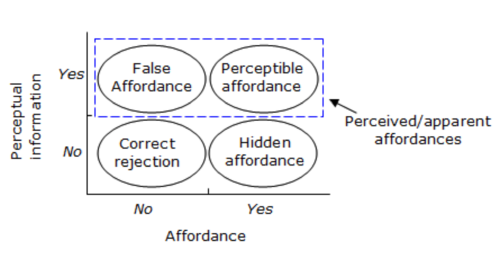Affordances
From DigitalRhetoricCollaborative
An affordance is the qualities or properties of an object that allow it to be put into use or action. [1] The origin of word comes from the field of psychology and their effort to understand the relationship animals (human beings) and human interaction have with other organisms and environments. Over time, with the help of James Gibson, Don Norman and Janet Murray, the term has evolved to be related to Human Computer Interaction (HCI) to described possible actions between humans and computers, digital text and media.
Contents |
[edit] James J. Gibson (Action Possibilities)
Psychologists James J. Gibson developed a theory called “The Theory of Affordances” in 1977. In it he explores the idea that affordances are possibilities for action and that the human population perceives the world not only in object shapes and spatial relationships, but in affordances or action possibilities.[2] He supports the idea that affordances act as clues or possibilities in the environment in relation to the action capabilities of and actor. His idea is that even though affordances are independent of the actor’s experience, knowledge, culture or ability to perceive, the affordances incite ones to take action. He feels that either affordances exsit or they do not because the existence is binary. For example, Gibson’s understanding is that stairs are an affordance in that they allow for the opportunity to travel a steep incline or door knobs provide the opportunity to open doors.
[edit] Donald Norman (Perceived Action Possibilities)
Don Norman, director of The Design Lab at University of California, states in his book, The Design of Everyday Things, his idea on what affordances are. He states that affordances are the perceived and actual properties of an object that determine how it could possibly be used. [3] For example his idea states that if an actor is presented with a tennis ball and a chair, he could sit on the ball and throw the chair. However, the actual properties of the objects such as their physical shape and material, combined with the perceived properties of picking up the ball and leaving the chair stationary, affordances are formed as a relationship between the two to pickup and throw the ball and sit on the chair. In his reasoning he states that affordances can be dependent on the experience, knowledge or culture of the one using object as they can make an action difficult or easy. This could lead to misunderstandings because of the ambiguous idea of individual perceiving of affordances. Norman proposed that there were degrees of perceiving affordances and it lead to differing types.
[edit] False Affordances
False affordances occur when there is no action possibility but the information presents itself with the object perceives there is.[4] For example, a chair made of cardboard is perceived to be a chair because of it’s shape and physical properties, but it is not suitable for its purpose which is to be sat on.
Hidden affordances occur when there are possibilities for action, but the person does not directly perceive them.[5] An example of this is a link in a document that is not highlight. It can direct a person to a website, but it looks like a regular type misleading the person.
Correct Rejection occurs when there is no present affordance and there is nothing to detect one. [6]
Perceptible affordances are where information is present and it can incite action upon the affordance to interact with the object. [7]
[edit] Janet Murray
Professor in the School of Literature, Media and Communication at the Georgia Institute of Technology, Janet Murray is well known for her contributions to human computer, digital media theory and her book Inventing the Medium. In her book she says affordances are a concept used in the field of human computer interaction to describe the functional properties of objects or environments-the properties that allow for particular uses. Within her definition she states that the digital medium has four affordances that make up the designer’s palette for representation in any digital format or genre and they are participatory, spatial, encyclopedic and procedural. [8]
[edit] Participatory
Participatory Affordance involves inviting human action and manipulation of the represented world. [9] When participatory affordance is present in a digital medium it allows an interactor to interact, contribute and manipulate content and computer processing to create interactivity.[10]
[edit] Spatial
Spatial Affordance involves information in regards to virtual space.[11] It can represent space using aspects of traditional media such as maps, images and video tracking and three-dimensional models. It is not however a function of visual representation, but a by-product of the procedural and participatory affordances that allow interaction in making sense of and navigating a fixed landscape through spatial metaphors.[12]
[edit] Encyclopedic
Encyclopedic Affordance containing very high capacity of information in multiple media formats.[13] It includes information in relation to its capacity, its extensive range of legacy and computational media formats and genres and its ability to represent any process though logical symbolic representation. [14]
[edit] Procedural
Procedural Affordance is composed of executable rules.[15] It is the affordance that allows users to specify conditional, executable instructions that create a new representational strategy. It allows the action of the computer to have visibility and parameters that are in the control of the user as well as create interactivity and transparent participation that results in agency for the interactor. [16]
[edit] References
- ↑ http://www.merriam-webster.com/dictionary/affordance
- ↑ James J. Gibson (1977), The Theory of Affordances. In Perceiving, Acting, and Knowing, edited by Robert Shaw and John Bransford, ISBN 0-470-99014-7.
- ↑ Don Norman (2013). The Design of Everyday Things (Revised and expanded ed.). Basic Books. p. 11.
- ↑ https://www.interaction-design.org/encyclopedia/affordances.html
- ↑ https://www.interaction-design.org/encyclopedia/affordances.html
- ↑ http://www.oxfordreference.com/view/10.1093/acref/9780199534067.001.0001/acref-9780199534067-e-1917
- ↑ http://www.paulolyslager.com/understanding-affordance-digital-interfaces/
- ↑ http://inventingthemedium.com/glossary/
- ↑ http://inventingthemedium.com/four-affordances/
- ↑ http://inventingthemedium.com/glossary/
- ↑ http://inventingthemedium.com/four-affordances/
- ↑ http://inventingthemedium.com/glossary/
- ↑ http://inventingthemedium.com/four-affordances/
- ↑ http://inventingthemedium.com/glossary/
- ↑ http://inventingthemedium.com/four-affordances/
- ↑ http://inventingthemedium.com/glossary/
[edit] External Links
James Gibson, Theory of Affordances
--Makimsey Morris

